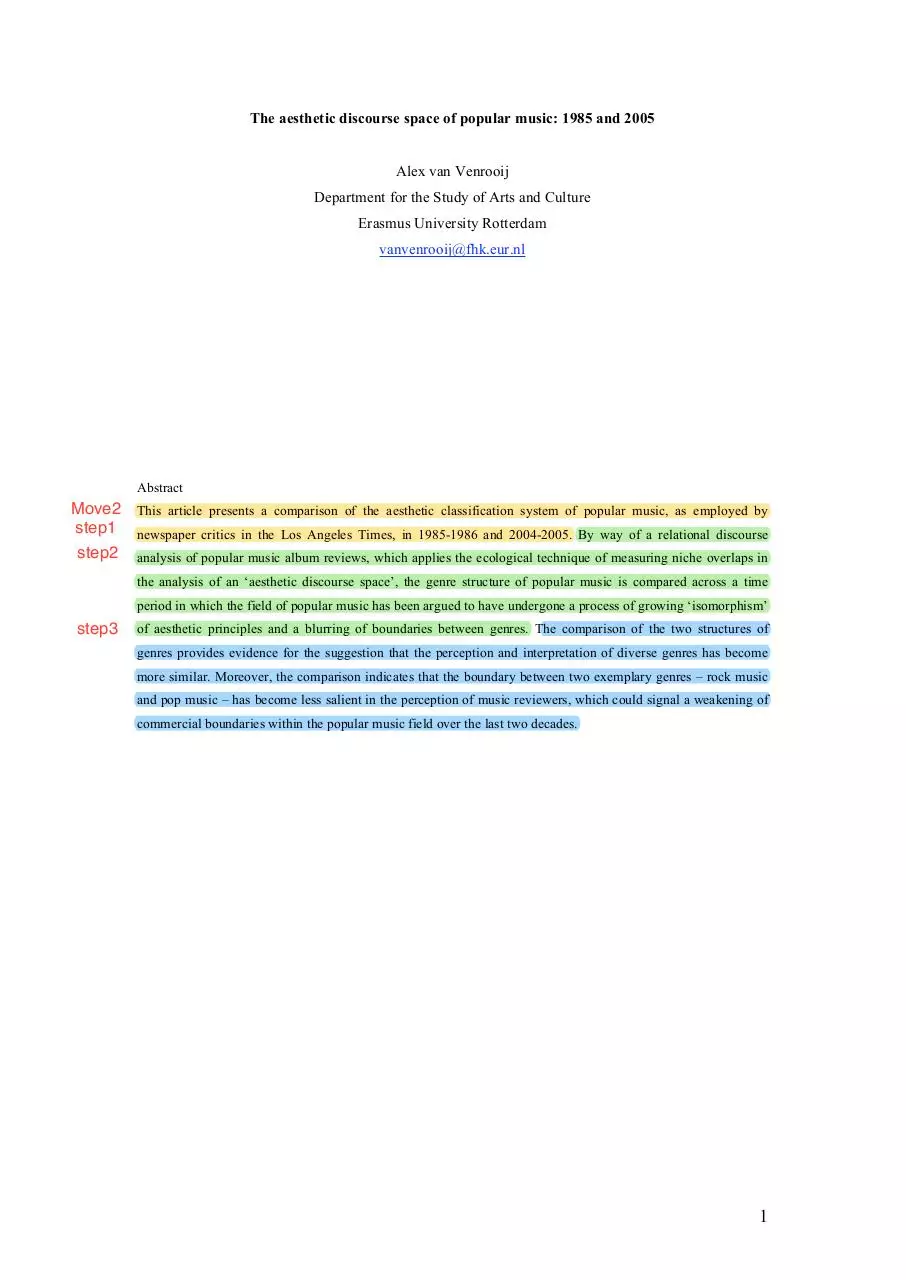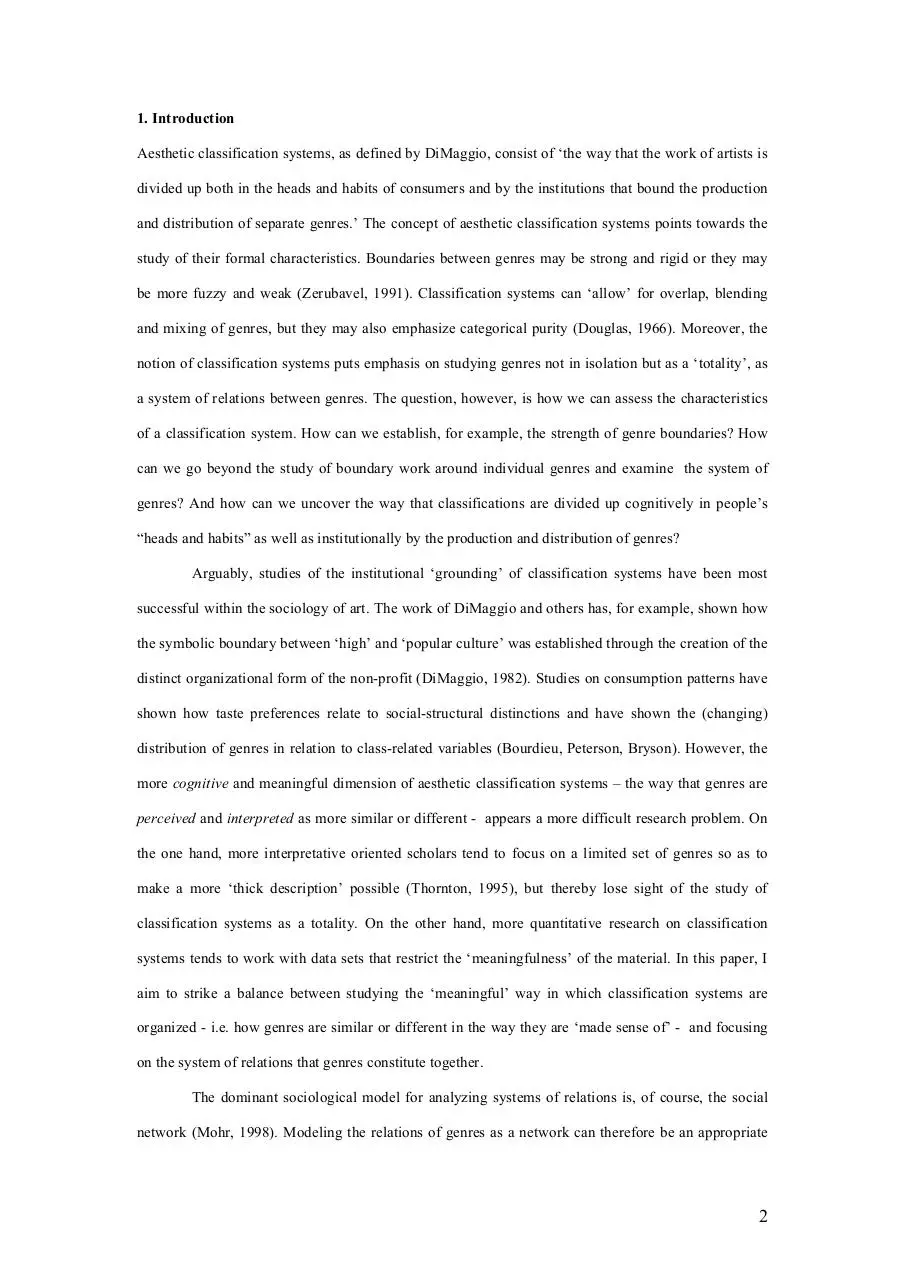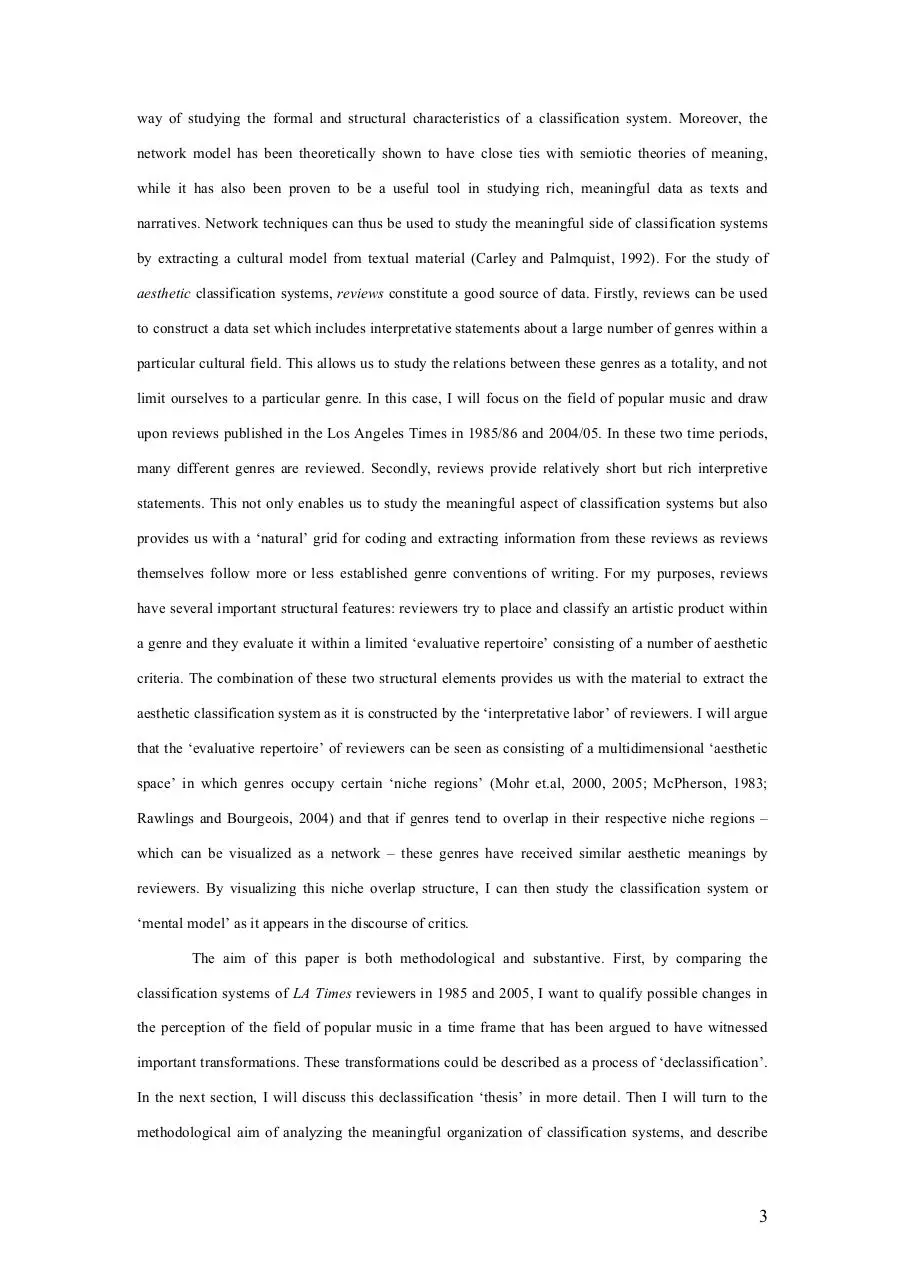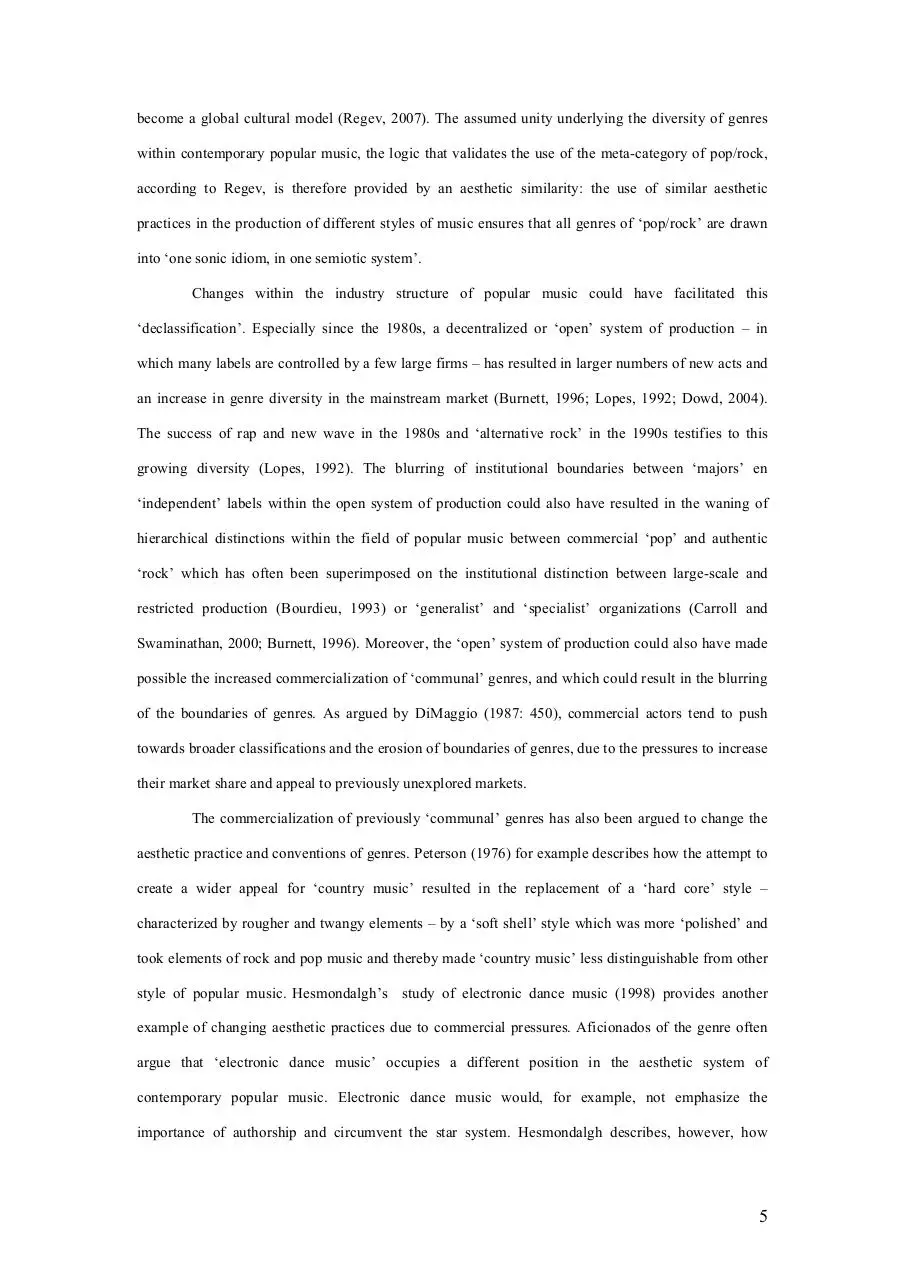ContentServer.asp 10 (PDF)
File information
Title: The aesthetic space of pop_asa
Author: Alex van Venrooij
This PDF 1.3 document has been generated by Adobe Acrobat 7.0 / Mac OS X 10.10 Quartz PDFContext, and has been sent on pdf-archive.com on 12/11/2014 at 10:24, from IP address 129.215.x.x.
The current document download page has been viewed 976 times.
File size: 395.09 KB (22 pages).
Privacy: public file





File preview
The aesthetic discourse space of popular music: 1985 and 2005
Alex van Venrooij
Department for the Study of Arts and Culture
Erasmus University Rotterdam
vanvenrooij@fhk.eur.nl
Abstract
Move2 This article presents a comparison of the aesthetic classification system of popular music, as employed by
step1 newspaper critics in the Los Angeles Times, in 1985-1986 and 2004-2005. By way of a relational discourse
step2 analysis of popular music album reviews, which applies the ecological technique of measuring niche overlaps in
the analysis of an ‘aesthetic discourse space’, the genre structure of popular music is compared across a time
period in which the field of popular music has been argued to have undergone a process of growing ‘isomorphism’
step3
of aesthetic principles and a blurring of boundaries between genres. The comparison of the two structures of
genres provides evidence for the suggestion that the perception and interpretation of diverse genres has become
more similar. Moreover, the comparison indicates that the boundary between two exemplary genres – rock music
and pop music – has become less salient in the perception of music reviewers, which could signal a weakening of
commercial boundaries within the popular music field over the last two decades.
1
1. Introduction
Aesthetic classification systems, as defined by DiMaggio, consist of ‘the way that the work of artists is
divided up both in the heads and habits of consumers and by the institutions that bound the production
and distribution of separate genres.’ The concept of aesthetic classification systems points towards the
study of their formal characteristics. Boundaries between genres may be strong and rigid or they may
be more fuzzy and weak (Zerubavel, 1991). Classification systems can ‘allow’ for overlap, blending
and mixing of genres, but they may also emphasize categorical purity (Douglas, 1966). Moreover, the
notion of classification systems puts emphasis on studying genres not in isolation but as a ‘totality’, as
a system of relations between genres. The question, however, is how we can assess the characteristics
of a classification system. How can we establish, for example, the strength of genre boundaries? How
can we go beyond the study of boundary work around individual genres and examine the system of
genres? And how can we uncover the way that classifications are divided up cognitively in people’s
“heads and habits” as well as institutionally by the production and distribution of genres?
Arguably, studies of the institutional ‘grounding’ of classification systems have been most
successful within the sociology of art. The work of DiMaggio and others has, for example, shown how
the symbolic boundary between ‘high’ and ‘popular culture’ was established through the creation of the
distinct organizational form of the non-profit (DiMaggio, 1982). Studies on consumption patterns have
shown how taste preferences relate to social-structural distinctions and have shown the (changing)
distribution of genres in relation to class-related variables (Bourdieu, Peterson, Bryson). However, the
more cognitive and meaningful dimension of aesthetic classification systems – the way that genres are
perceived and interpreted as more similar or different - appears a more difficult research problem. On
the one hand, more interpretative oriented scholars tend to focus on a limited set of genres so as to
make a more ‘thick description’ possible (Thornton, 1995), but thereby lose sight of the study of
classification systems as a totality. On the other hand, more quantitative research on classification
systems tends to work with data sets that restrict the ‘meaningfulness’ of the material. In this paper, I
aim to strike a balance between studying the ‘meaningful’ way in which classification systems are
organized - i.e. how genres are similar or different in the way they are ‘made sense of’ - and focusing
on the system of relations that genres constitute together.
The dominant sociological model for analyzing systems of relations is, of course, the social
network (Mohr, 1998). Modeling the relations of genres as a network can therefore be an appropriate
2
way of studying the formal and structural characteristics of a classification system. Moreover, the
network model has been theoretically shown to have close ties with semiotic theories of meaning,
while it has also been proven to be a useful tool in studying rich, meaningful data as texts and
narratives. Network techniques can thus be used to study the meaningful side of classification systems
by extracting a cultural model from textual material (Carley and Palmquist, 1992). For the study of
aesthetic classification systems, reviews constitute a good source of data. Firstly, reviews can be used
to construct a data set which includes interpretative statements about a large number of genres within a
particular cultural field. This allows us to study the relations between these genres as a totality, and not
limit ourselves to a particular genre. In this case, I will focus on the field of popular music and draw
upon reviews published in the Los Angeles Times in 1985/86 and 2004/05. In these two time periods,
many different genres are reviewed. Secondly, reviews provide relatively short but rich interpretive
statements. This not only enables us to study the meaningful aspect of classification systems but also
provides us with a ‘natural’ grid for coding and extracting information from these reviews as reviews
themselves follow more or less established genre conventions of writing. For my purposes, reviews
have several important structural features: reviewers try to place and classify an artistic product within
a genre and they evaluate it within a limited ‘evaluative repertoire’ consisting of a number of aesthetic
criteria. The combination of these two structural elements provides us with the material to extract the
aesthetic classification system as it is constructed by the ‘interpretative labor’ of reviewers. I will argue
that the ‘evaluative repertoire’ of reviewers can be seen as consisting of a multidimensional ‘aesthetic
space’ in which genres occupy certain ‘niche regions’ (Mohr et.al, 2000, 2005; McPherson, 1983;
Rawlings and Bourgeois, 2004) and that if genres tend to overlap in their respective niche regions –
which can be visualized as a network – these genres have received similar aesthetic meanings by
reviewers. By visualizing this niche overlap structure, I can then study the classification system or
‘mental model’ as it appears in the discourse of critics.
The aim of this paper is both methodological and substantive. First, by comparing the
classification systems of LA Times reviewers in 1985 and 2005, I want to qualify possible changes in
the perception of the field of popular music in a time frame that has been argued to have witnessed
important transformations. These transformations could be described as a process of ‘declassification’.
In the next section, I will discuss this declassification ‘thesis’ in more detail. Then I will turn to the
methodological aim of analyzing the meaningful organization of classification systems, and describe
3
the application of the methods developed by Mohr et. al (2000, 2005) on modeling discourse structures
by drawing on the ecological concept of ‘niche spaces’. Next, I will discuss and compare the extracted
model of the aesthetic classification system of LA Times popular music reviewers in 1985 and 2005.
2. Classification systems of popular music in transition
The contemporary field of popular music has been argued to exhibit many signs of the process that
DiMaggio (1991) describes as ‘declassification’. The field seems to have become more differentiated
and characterized by a plethora of styles and genres. This differentiation has been related to increased
demands for more finely grained ‘ritual classifications’ or the need for cultural resources to mark the
social boundaries of various style groups and subcultures (McLeod, 2001; Thornton, 1995). The
boundaries between genre categories have also apparently weakened. The appearance of hybrid genres
such as techno-rock, world-beat and rap-metal, in which aesthetic elements from different ‘genre
worlds’ are combined, indicates that producers, consumers and intermediaries might have become less
purist in their boundary drawing. It can also be argued that the way in which hierarchical boundaries
are drawn within the field of popular music has changed. Until the mid 1980s, hierarchical distinctions
between ‘serious’ and ‘authentic’ rock music and ‘frivolous’, commercial pop music were more firmly
based on the application of principles of distinction that mirrored the boundary between ‘art’ and
‘commerce’. In contrast, the contemporary field of popular music seems to be characterized by an
‘intermediate aesthetic’ which combines commercial and artistic values (Lindberg et. al., 2000).
Regev (2002) describes the process of declassification in the field of popular music as a
process of ‘pop-rockization’. He argues that increasingly more styles and genres occupy the field of
popular music and the boundaries between genres such as rap/hiphop, electro-dance, mainstream pop,
heavy metal, alternative rock, reggae, ‘classic’ rock are less strictly drawn and are lumped together into
a meta-category of ‘pop/rock’. The increasing use of the label pop/rock signals the waning of the
hierarchical distinction between the ‘heavy, hard and difficult’ (i.e. rock) and the ‘light, soft and easy’
(i.e. pop). Regev regards this as indicative of an underlying cultural logic, a ‘pop/rock aesthetic’, which
allows for the grouping of these diverse genres into one meta-category. All these genres are connected
by their reliance on similar creative practices: electric and electronic sound textures, amplification,
studio craftsmanship and a vocal delivery that can be characterized as ‘untrained’ or ‘spontaneous’.
This pop/rock aesthetic has furthermore expanded within a global field of pop-rock in which it has
4
become a global cultural model (Regev, 2007). The assumed unity underlying the diversity of genres
within contemporary popular music, the logic that validates the use of the meta-category of pop/rock,
according to Regev, is therefore provided by an aesthetic similarity: the use of similar aesthetic
practices in the production of different styles of music ensures that all genres of ‘pop/rock’ are drawn
into ‘one sonic idiom, in one semiotic system’.
Changes within the industry structure of popular music could have facilitated this
‘declassification’. Especially since the 1980s, a decentralized or ‘open’ system of production – in
which many labels are controlled by a few large firms – has resulted in larger numbers of new acts and
an increase in genre diversity in the mainstream market (Burnett, 1996; Lopes, 1992; Dowd, 2004).
The success of rap and new wave in the 1980s and ‘alternative rock’ in the 1990s testifies to this
growing diversity (Lopes, 1992). The blurring of institutional boundaries between ‘majors’ en
‘independent’ labels within the open system of production could also have resulted in the waning of
hierarchical distinctions within the field of popular music between commercial ‘pop’ and authentic
‘rock’ which has often been superimposed on the institutional distinction between large-scale and
restricted production (Bourdieu, 1993) or ‘generalist’ and ‘specialist’ organizations (Carroll and
Swaminathan, 2000; Burnett, 1996). Moreover, the ‘open’ system of production could also have made
possible the increased commercialization of ‘communal’ genres, and which could result in the blurring
of the boundaries of genres. As argued by DiMaggio (1987: 450), commercial actors tend to push
towards broader classifications and the erosion of boundaries of genres, due to the pressures to increase
their market share and appeal to previously unexplored markets.
The commercialization of previously ‘communal’ genres has also been argued to change the
aesthetic practice and conventions of genres. Peterson (1976) for example describes how the attempt to
create a wider appeal for ‘country music’ resulted in the replacement of a ‘hard core’ style –
characterized by rougher and twangy elements – by a ‘soft shell’ style which was more ‘polished’ and
took elements of rock and pop music and thereby made ‘country music’ less distinguishable from other
style of popular music. Hesmondalgh’s study of electronic dance music (1998) provides another
example of changing aesthetic practices due to commercial pressures. Aficionados of the genre often
argue that ‘electronic dance music’ occupies a different position in the aesthetic system of
contemporary popular music. Electronic dance music would, for example, not emphasize the
importance of authorship and circumvent the star system. Hesmondalgh describes, however, how
5
economic pressures have pushed independent music labels to cooperation with ‘the majors’ and
thereby also pushing dance acts into the direction of adopting many of the aesthetic features of rock
acts – as in the case of The Prodigy. Even though the discourse on electronic music has often been
couched in an almost postmodern discourse on the deconstruction of the author as writer, the dance
music field has adopted the ‘authorship policies’ of rock culture (Hesmondalgh, 1998: 247).
The question I want to address in this paper is if this assumed process of declassification – the
blurring of genre boundaries – can be found on the level of the perception and evaluation of popular
music albums by critics. Has the perception of aesthetic boundaries of popular music genres by critics
changed over the last 20 years? From a field theoretical perspective, studying the classification system
of critics is important for several reasons. In general, field theory emphasizes the importance of
symbolic and meaningful distinctions as co-constitutive of field structures. Central to the work of
Bourdieu, for example, is the assumption of a correspondence between social and mental structures,
between the objective divisions of the social world – particularly into dominant and dominated in the
various fields and the principles of vision and division that agents apply to it’ (Bourdieu and Wacquant,
1992: 12). This assumption of a duality of structure and culture points us towards investigating the way
in which actors within the field of popular music perceive the structure of the field, or in other words,
the symbolic system of a cultural field. The blurring of institutional boundaries between ‘majors’ and
‘indies’ in the open system of production could by this logic also affect the symbolic classifications of
actors within the field – and for example push towards eroding the boundaries between ‘art’ and
‘commerce’. As Bourdieu also argues, critics in cultural fields are producers of symbolic systems and
influential actors in the struggle over the ‘dominant principles of vision and division’ in cultural fields.
Moreover, critics are argued to patrol the internal boundaries of cultural fields between the large-scale
and the restricted pole. Since in the subfield of restricted production, producers produce predominantly
for other producers, and aim for evaluation according to field internal criteria, critics and critical
success become important sources of legitimation among producers within the restricted subfield of
production. Commercial success and wide appeal with non-producers are the heteronomous criteria
which operate predominantly within the subfield of large-scale production. In this view, critics are
performing the ‘boundary work’ between the ‘artistic’ and ‘commercial’ pole of cultural fields
(Baumann, 2001). However, this role of critics might be more characteristic for autonomous cultural
fields which are internally more strongly bounded and partitioned, but critics might have a more
6
ambiguous status within fields with fuzzy internal boundaries between the restricted and large-scale
subfields. Critics might be less inclined to draw strong distinctions between ‘commercial’ and ‘artistic’
in fields in which the institutional structure is also less bounded.
Within the field of journalistic criticism, there might however also be internal variation and
struggle over symbolic systems (Cf. Zuckerman and Kim, 2003). The type and formal characteristics of
the classifications drawn, have been found to depend on actors’ relative positions within the field. For
example, critics writing for national newspapers might perceive boundaries between genres as less
distinct than their colleagues writing for more specialized publications that have a more segmented
audience. As DiMaggio has argued, ‘structural consolidation’ could have an influence on the strength
of artistic boundaries. When persons occupy similar positions on several dimensions, classifications
will be strongly defended. The more general-oriented media outlets – such as national newspapers,
which have a broader readership in terms of socio-demographic variables – are therefore likely to
defend genre boundaries to a lesser extent. Moreover, critics writing for newspapers and magazines
located more to the heteronomous pole of the journalistic field might also be more likely to use
commercial values in evaluating cultural goods and perceiving less distinction between commerce and
art then critics writing for newspapers or magazines located at the autonomous pole of the journalistic
field.
With these considerations in mind, the aim of this paper is not to study field variation between
newspaper outlets in their classification systems. The aim is to make a longitudinal comparison of the
classification system of genres from the perspective of one particular national newspaper, the LA
Times, across a time period in which it has been argued that a symbolic declassification has occurred.
The LA Times is chosen as a widely distributed newspaper with a readership that is varied in social
demographic variables and more importantly, can be said to discuss and review a wide variety of
popular music genres. Although, of course, the LA Times selects only a specific - and because of the
large extent of the popular music field in terms of yearly produced albums and active artists, only
relatively small - subset of the field of popular music, the LA Times is relatively varied in its attention
in terms of genres, but also on reporting on both the mainstream centre market (artists and albums that
appear on the Billboard charts) as well as more peripheral and ‘specialists’ music genres. The inclusive
and more encompassing perspective of the field within the LA Times, makes the study of how the
7
perception of the field has changed possible. Although our study is therefore limited to only one
newspaper, the units of which the classification system is constructed are multiple and diverse.
2. Structural analysis of the discourse of music reviews
How can we extract a model of the classification system from the discourse of critics? In extracting the
classification system, I will follow the three core principles of structuralist analysis (Levi-Strauss,
1963; Mohr, 1998). First, I will identify elementary components of which the discourse of reviewers is
constructed. Second, I will identify how these elements are positioned vis-à-vis each other through
relations of similarity and difference. Third, I will analyze the overall structure of these relations (‘the
relations of relations’).
The first step in the structural analysis of music reviews consists of identifying two basic
elements in the popular music discourse: (1) the use of genre labels to classify artists/albums within
more general categories and (2) the use of evaluative criteria which can consist of sentences, short text
passages or words that have evaluative meaning. These elementary units of the discourse are coded on
a low level of generalization. An effort is made to stay as close to the text as possible and postpone the
aggregation to larger semantic categories. This approach differs from other content analytic studies in
that it tries to avoid generalization at the lower level of analysis by not working with a preconceived
coding scheme (Cf. Roberts, 1989; Franzosi, 1989). Especially for research that wants to gauge the
characteristics of classification systems it can lead to problems of circularity to assume (for example in
the devising of a coding form) the content of categories and their boundaries. The ‘anti-categorical’
imperative of structural analysis therefore seems preferable in studying classifications and boundaries
(Emirbayer, 1997; Cf. DiMaggio, 1986). Although the typification of the discourse into different
‘aesthetics’ is not the aim of this paper (cf. Van Venrooij and Schmutz, forthcoming), I do in fact find
the typical kinds of criteria discussed in the literature on popular music discourse, for example, by Frith
(1996) on the ‘art’, ‘folk’ and ‘pop’ discourses. Traditional ‘art’ criteria such as innovation,
authenticity, authorship and creativity appear in these reviews. ‘Pop’ criteria which frame popular
music as a form of entertainment and a commercial product also are found in, for example,
emphasizing the ‘accessibility’ of the music, the functional uses to which it can be put, and the overall
enjoyable experience which it can generate. ‘Folk’ values that emphasize the connection between ‘art’
8
and ‘life’ can also be found in the critical discourse, for example in the degree of realism and
credibility of the performer and the music.
The second step in the structural analysis consists of assessing relations of similarity and
difference among the categories of genres. As a measure of similarity, I will use the concept of
‘structural equivalence’ which posits that elements which have similar relations with other elements are
considered similar. In this case then, if genres have similar relations to evaluative criteria, or in other
words, have similar ‘evaluative profiles’, they are considered as similar. This is consistent with the idea
of genres as sets of conventions, which guide expectations and provide ‘standards for evaluating and
appreciating cultural objects’ (Crane, 1992: 112). ‘Authenticity’ or ‘expressivity’ might for example be
central to the discourse on country music, but less so for electronic dance music. Connotations can also
vary between genres: soul is associated with ‘smooth and sweet’, punk with ‘raw and rough’, pop with
‘light and easy’ and rock with ‘heavy and difficult’. Behavioral rules also apply differently to genres:
intimate revelatory music by a singer/songwriter should be listened to quietly and more
contemplatively whereas hip-hop and R&B are more often associated with dancing or other functional
values. In other words, genres can be said to have different ‘affordance’ structures (DeNora, 2000).
They are situated in a semiotic space of values, connotations, uses, etc. Therefore it can also be argued
that genres can be considered more or less similar in meaning by taking into account which meanings
are attributed to them by reviewers. If genres receive similar evaluative judgments and are treated the
same by reviewers in terms of the criteria used to evaluate them, these genres can be said to be similar
in meaning. The closer together in semiotic space, the more similar I consider genres to be.
The third step then consists of analyzing the structural mapping of the relations of genres, or
assessing the structure of the relations of genre as a whole. As argued by semiotic and structuralist
theories, the meaning of each individual genre must be considered through its structural position within
the overall relational system of how each genre is positioned vis-à-vis all other genres. To assess this
overall relational structure, I will conceptualize genres as occupying niche spaces within the aesthetic
discourse space and consider the overlap structure of genres. The assessment of the position of genres
within the aesthetic discourse space therefore proceeds in two steps. (1) I will assess how reviewers
position individual artists and albums within the aesthetic discourse space. Every genre classification of
an artist/album is treated then as a discrete unit of meaning. (2) Since each individual album/artist has
received a genre classification, it is then possible to conceptualize the position of a genre as a
9
Download ContentServer.asp-10
ContentServer.asp-10.pdf (PDF, 395.09 KB)
Download PDF
Share this file on social networks
Link to this page
Permanent link
Use the permanent link to the download page to share your document on Facebook, Twitter, LinkedIn, or directly with a contact by e-Mail, Messenger, Whatsapp, Line..
Short link
Use the short link to share your document on Twitter or by text message (SMS)
HTML Code
Copy the following HTML code to share your document on a Website or Blog
QR Code to this page

This file has been shared publicly by a user of PDF Archive.
Document ID: 0000193762.